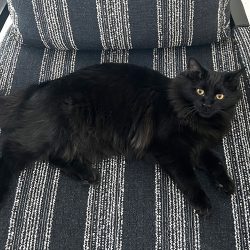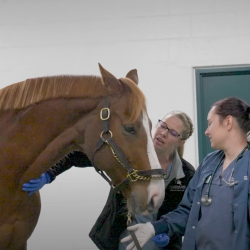By Dr. Leanne Magestro, MSU Radiation Oncology Service, and Dr. Stephan Carey, MSU Internal Medicine Service; Featuring Dr. Lauren Kustasz, resident for the MSU Internal Medicine Service, and Elizabeth Jackson, second-year DVM student
History and Presentation
Dumbledore is a 10-year-old neutered male Oriental Shorthair who was presented to the Michigan State University Radiation Oncology Service in January of 2020 for evaluation of anisocoria. In December of 2019, Dumbledore’s owner noticed a subtle left-sided anisocoria and a slight flare-up of his chronic rhinitis. At the end of December, Dumbledore was evaluated by an ophthalmologist who appreciated the anisocoria and recommended an MRI. Dumbledore had previously been worked up for his rhinitis in 2017, which is managed at home by his owner, a veterinarian and feline specialist, with courses of Zeniquin and low-dose Prednisolone as needed. In 2017, Dumbledore also had staged full mouth extractions. Dumbledore has a history of a heart murmur which is monitored with regular imaging and atenolol.

At the time of presentation, Dumbledore had more nasal congestion than normal. He also had been scratching at his ears (L>>R) more frequently. Dumbledore eats Royal Canine Ultamino and Hydrolyzed Protein at home.
An MRI was performed, and no overt abnormalities associated with the ocular structures or the brain were noted; however, there were changes in the nasal passages and right frontal sinus consistent with inflammation/ rhinitis. Due to Dumbledore’s history of chronic rhinitis, biopsies of his nasal passages were taken for histopathology and a sample was obtained for bacterial, mycoplasma, and fungal culture. Dumbledore’s nasal passages were lavaged with sterile saline following the procedure.
Diagnosis
The results of the MRI, nasal histopathology, and cultures were consistent with feline chronic (lymphoplasmacytic) rhinitis. Dumbledore’s rhinitis was managed with a combination of antibiotics and oral prednisolone and was only marginally responsive. Four months later, Dumbledore was re-presented to the MSU Radiation Oncology Service for consultation regarding low dose radiation therapy as a management option for his, refractory, lymphoplasmacytic rhinitis.
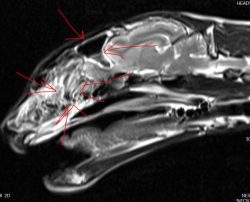
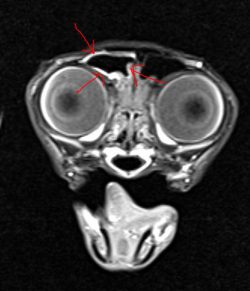
Treatment and Outcome
A total of 6 Gy was prescribed to Dumbledore’s nasal cavity and frontal sinuses in 3 fractions of 2 Gy once daily under general anesthesia in a clinical setup guided by the previously acquired MRI.
Radiation therapy, dose 1 of 3: Dumbledore required a large dose of premedication and induction drugs, and subsequently became hypotensive during anesthesia with desflurane inhalant. Radiation treatment, and recovery went well. Due to high volume of induction drugs needed and the hypotension during anesthesia, the team elected to give gabapentin 100 mg PO q12 for sedation, and to temporarily stop his atenolol therapy.
Radiation therapy, dose 2 of 3: Gabapentin resulted in minimal sedation. Dumbledore’s heart rate on physical exam was approximately 200 with no gallop. There was mild improvement to nasal signs with decreased nasal discharge. Anesthesia, treatment, and recovery went well. The team used sevoflurane to minimize induction of tachycardia. His Doppler blood pressure was in the low 60s mmHg throughout.
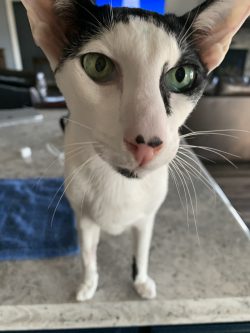
Radiation therapy, dose 3 of 3: Dumbledore did well overnight. He had no nasal discharge and only a small amount of stertor when at rest. There was no upper airway noise. His heart rate was 160 in the morning with no gallop. In this round, anesthesia, treatment, and recovery went well. His Doppler BP was high 50s/low 60s.
Dumbledore completed a course of radiation therapy for his rhinitis. He did well overall under anesthesia with some adjustments. He did not experience any side effects of treatment and none are expected. It is possible that the black fur over his frontal sinuses may grow in gray to white over the coming months. There is also a very small chance he could develop a cataract in one or both eyes over time, but this is considered extremely rare.
One year since treatment, Dumbledore has been reported to be doing well at home. His owner reports that radiation therapy made a marked positive impact on his quality of life.

Comments
Radiation therapy is not routinely offered for non-neoplastic inflammatory disease in the United States but is sometimes considered for non-neoplastic diseases such as trigeminal neuralgia, villonodular synovitis, and plantar fasciitis. The only existing veterinary literature is related to elbow osteoarthritis in dogs that is refractory to medical management. Given that lymphocytes are exquisitely sensitive to photon irradiation, we would expect an anti-inflammatory response with low doses.
Dumbledore’s prescription was chosen based on one of the canine osteoarthritis studies (*Rossi 2018). Three fractions were chosen over a single fraction to minimize the risk of any late side effects of radiation therapy to the tissues surrounding the nasal cavity. Since he has benefited for over a year from this treatment, we could consider additional radiation therapy in the future if he experiences a relapse.
*Federica Rossie et al. Megavoltage Radiotherapy for the Treatment of Degenerative Joint Disease in Dogs: Results of a Preliminary Experience in an Italian Radiotherapy Centre. Front Vet Sci 2018.
SAFETY AND EFFICACY OF LOW-DOSE RADIATION THERAPY AS A MODALITY FOR THE MANAGEMENT OF FELINE CHRONIC RHINITIS
Drs. Stephan Carey of the MSU Internal Medicine Service and Dr. Leanne Magestro are investigating the safety and efficacy of low-dose external beam radiation therapy as a treatment modality for chronic rhinitis in cats. Rhinitis is a very common condition and a very frustrating disease to treat. It is typically treated with various combinations of antibiotics and anti-inflammatory medications (usually oral or inhaled steroids), and treatment failures or relapses are very common.
Last year, Dr. Magestro treated Dumbledore Kitson, the cat featured in the case study above. Dumbledore is owned by Dr. Jill Kitson, a small animal veterinarian and feline specialist in Fort Wayne, Indiana. Dumbledore was presented initially for evaluation of some neurologic signs, but he also had a history of chronic rhinitis that Dr. Kitson had been managing unsuccessfully with traditional therapy. They discussed the option of low-dose radiation therapy as a potential treatment modality for his rhinitis, and they elected to treat him this past March.
Radiation therapy is a novel therapeutic option for this condition and has not been reported or published anywhere to date. The dose of radiation delivered is very low and the treatment is tailored to deliver the dose only to the nose and spare the surrounding tissue.
As such, the MSU College of Veterinary Medicine is preparing to start enrolling patients in a clinical trial evaluating radiation therapy in feline chronic rhinitis. This is a joint project among Dr. Magestro, Dr. Lauren Kustasz (resident with the MSU Internal Medicine Service), and Dr. Stephan Carey. We also are collaborating with an internist at Oakland Veterinary Referral Services (Dr. Kaitlin Lonc), and a second-year veterinary medicine student (Elizabeth Jackson).


